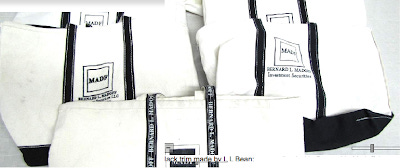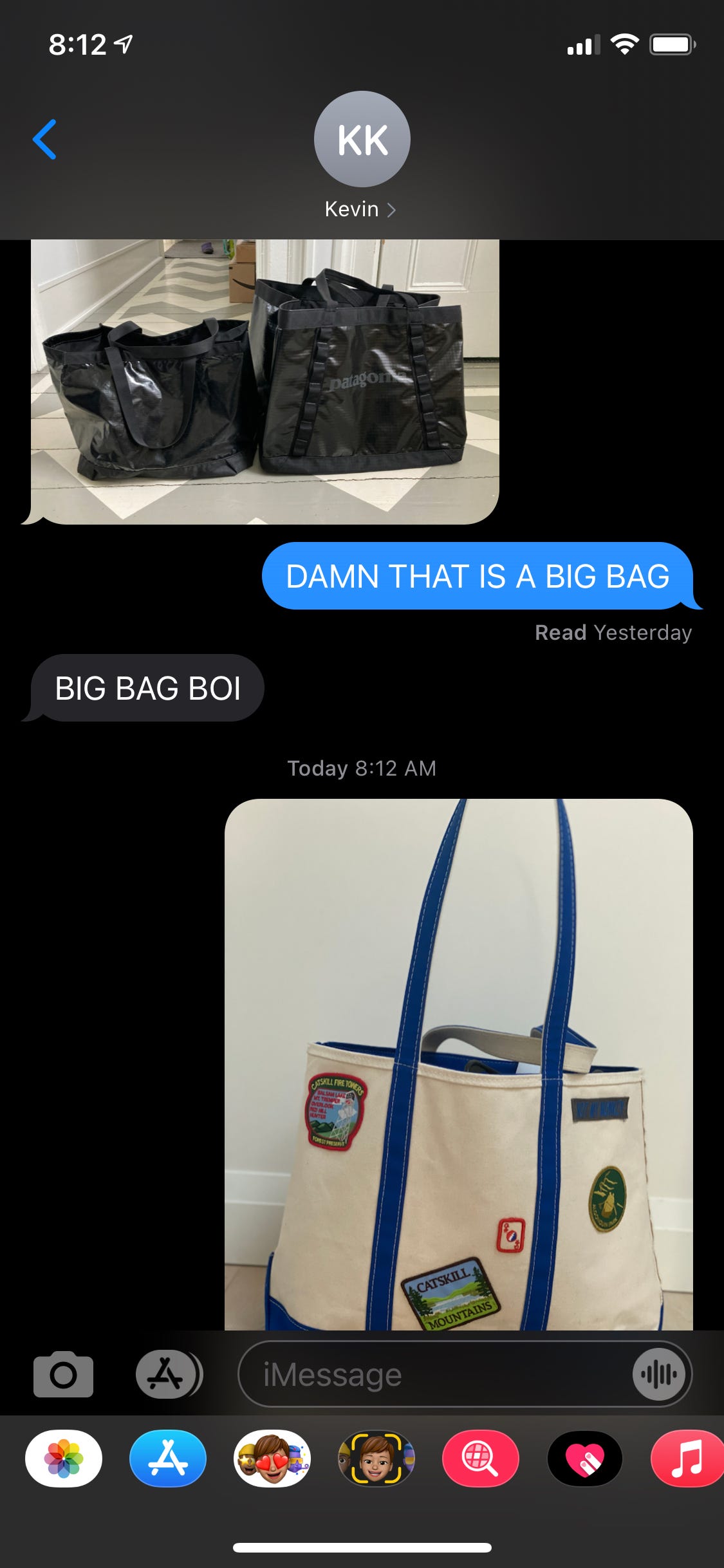A quick welcome to this weeks new subscribers! Last week was our most read and shared issue yet and Kevin and I appreciate all your support.
There is a clear hierarchy in the (quite large) tote bag collection in our house. At the top, is the LL Bean Boat and Tote, a sturdy tote with a reinforced bottom and handles that can fit all you need for a day at the beach or a weekend getaway.
Second, is a tote bag made in Maine by Hyperlight Mountain Gear out of a fabric called Cuben. Is it absolute overkill to have a tote bag that weighs less than an ounce but that can carry hundreds of pounds? Yes, but it was on sale. (The closest thing I could find still in production is this version by SDR Traveller, the luggage company of globetrotting anthropologist Jan Chipchase). Kevin’s favourite tote is the Patagonia Black Hole Tote Bag 25L, but he’s also totally pumped for the arrival of his recently ordered and upsized 61L version. That’s a lot of bag.
With travel baggage being replaced by pandemic-related emotional baggage, I wanted to dig into one of my favourite everyday items: tote bags.
Design
Writing Considered has some interesting side effects. While researching this article, I found myself on the website of a tiny family museum in Coshocton, Ohio, for the second time. The Johnson-Humrickhouse Museum is the proud custodian of the first known “promotional tote”, made in 1886.
The founding myth of the promotional products industry is that Jasper Meek, local newspaper man, saw a girl drop her books into the dirt on her way to school and it inspired an idea for his friend Cantwell (first name lost to history), who owned Cantwell Shoes. Meek had local seamstresses make the bags and used his printing press to print the logo. The Cantwell Bag is like the shroud of Turin for the $2 billion promotional products industry.
Meek had a local competitor, Henry Beach, who also owned a newspaper press. They competed on who could brand the most objects, including buggy whips and bags for marbles. If I forget, please remind me to organize a celebration of 150 years of useless corporate swag in 2036.
Next in line for top-ranked totes I own are all the printed bags I carry so that cool people can easily tell that I am also cool. These include the Erewhon market jute tote that lets everyone know I travel and love overpaying for healthy snacks, and other favourites from my local grocery stores Fiesta Farms and Summerhill Market.
This year, Stella Bugbee of The Cut coined the term Zizmorcore to encapsulate the trend of people wrapping themselves in artifacts of their local favourites (restaurants, museums, etc.). The name comes from Dr. Zizmor, a dermatologist that used to advertise so relentlessly in the NYC subways that when he stopped, his posters became art objects treasured by “in the know” New Yorkers. Consider me a Zizzer.
Innovation
LL Bean did not invent the tote, but they definitely perfected it. Started in 1912 as a fishing and outdoor goods retailer by Leon Leonwood Bean (so nice they named him twice), the company has become famous for a couple key products and its (formerly) ironclad warranties.
As you might have guessed by now, my personal favourite product of theirs is the Boat and Tote. Jake Ghallagher, in a great piece on A Continuous Lean, wrote “They’re the perfect size to fit a change of clothes, some reading material, and of course, that crucial sixer.” For some American East Coasters who may identify as “preppy”, it is almost their own piece of Zizmorcore. When the artist Cynthia Talmadge built a series of imagined dorm rooms for four psychiatric treatment centers and rehab facilities, she kitted each room out with a corresponding Boat and Tote for a “hint of the boarding school aesthetic.”
The construction is fairly simple and refined. You can get a pattern to make your own here. Originally billed as an “ice bag”, people in the 1940s would store their ice in a separate “ice chest” as their freezers were unreliable. The bag is double layered on the bottom, has riveted handles, and is designed to carry up to 500 lbs. The bag was reissued in the 1960’s in the form and style that is known and loved today. It is so popular, the company reports selling over 500,000 per year.
Digging deeper into the innovation is a bit of a challenge here. The bag balances functionality, cultural cachet and value well. There are many knock offs, some from direct competitors like Lands Ends and others from high fashion brands that serve to reinforce the value and cachet of the original.
Sustainability/Economics
Going forward, Kevin and I will be expanding on this section - thanks for the suggestion, Xavier and Sean!
Sometimes there is not enough information available or the company refuses to answer questions about sustainability. LL Bean is one of those cases. They do not publish a sustainability report, did not respond to inquiry, nor do they subscribe to any of the supplier tracking or industry standards. The most recent information we could find was in a 2016 “About LL Bean” document. They are a private company and are not obligated to report publicly on any of these areas.
Where there is no sustainability story to tell, or where there is a more interesting economic or business one, we will tell it here.
In 2018, LL Bean ended its lifetime warranty program (featured in this great episode of This American Life) and replaced it with a one year warranty. Customers have had varied experiences, but it seems that you can return defective items outside the new 1 year warranty period, case-dependent. The company cited customers returning products that suffered from natural wear or heavy use as the reason for cancelling the lifetime warranty. As a result, there have been at least four lawsuits and LL Bean has been forced to grandfather the refund of items sold before the policy change.
This has opened up an opportunity for companies that maintain their lifetime guarantee. Competitors like Patagonia, Osprey, Arcteryx, and others now feature their warranties prominently. Warranties are a clear signal to customers that you stand behind your products. For new companies like Cotopaxi, they are an easy way to comfort customers who might have low awareness of your product quality.
Value
The best way to get a Boat and Tote is as a gift (thanks Sally and Duncan!) and for it to be customized either with your initial(s), or to commemorate an event. With prices starting at $29 and topping out at less than $100, they are an affordable alternative and easily pass Kevin’s $1/use test for items.
The durability and heritage of the Boat and Totes reward looking for a vintage model. Sometimes you can find amazing corporate swag versions online. A box of Bernie Madoff Securities totes went for $4,000 as part of his asset auction.
I love the look of this colour blocked version, and this perfectly distressed one is ideal if you want the world to know you’re a creative. To customize mine, I have taken to buying patches wherever I travel and sewing them to the bag.
Below, you can watch a quick video on how the Boat and Tote is made. Spoiler alert, they employ a woman named Rosie whose job it is to rivet the handles:
If you know either Kevin or I, or are getting to know us, the differences in our bag preferences are very telling:











